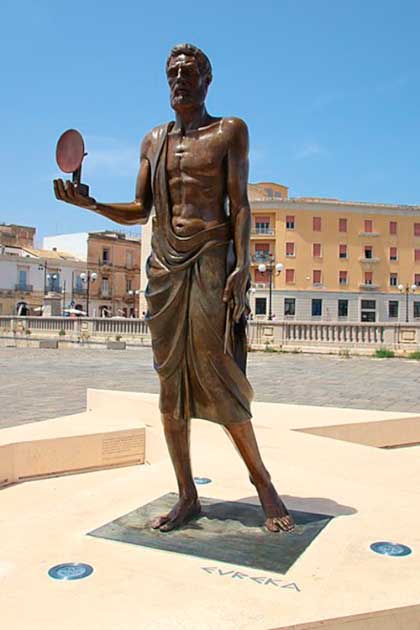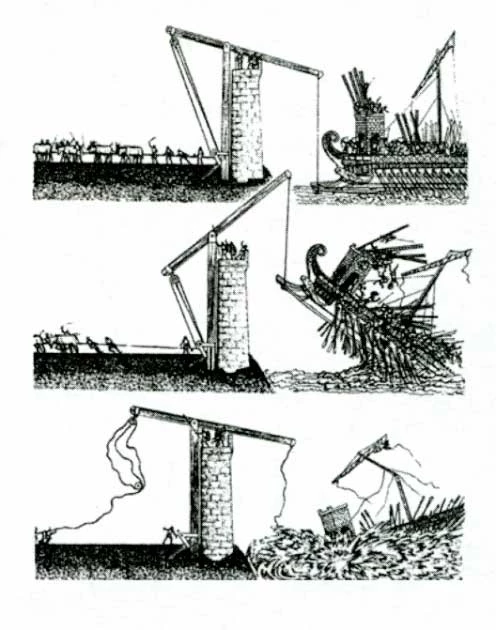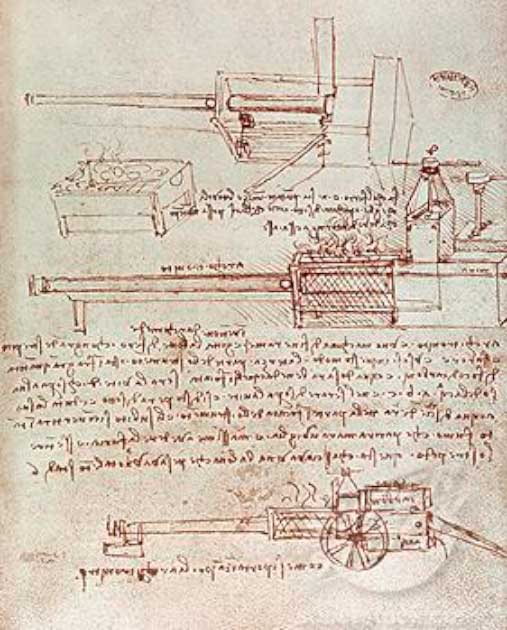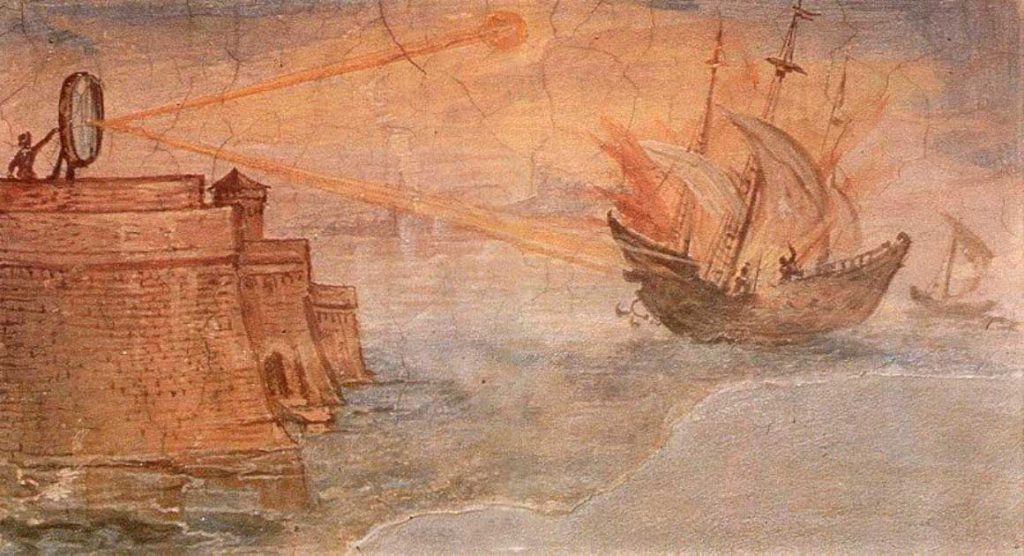The name Archimedes is well known to anyone who has learned about classical antiquity during history class at school. He is one of the founders of modern math and science and is considered by many to be the greatest engineer of all time.
Archimedes truly understood the principles of engineering under which he was operating, famously once saying “Give me a lever long enough and a fulcrum on which to place it and I shall move the world.” Although he was not the inventor of either concept he was able to calculate the load weight and the distance away from the fulcrum an object must be.
But there are other stories of Archimedes, where his genius and insight was pressed into the construction of far more dangerous creations. Beyond improving the use of the lever and fulcrum, Archimedes is known for his creative and possibly deadly war weapons.
Archimedes of Syracuse
Archimedes of Syracuse (287 – 212 BC) was a brilliant Greek engineer, astronomer, mathematician, physicist, and inventor from the city of Syracuse, on the Italian island of Sicily. Archimedes is often regarded as “one of the leading scientists of classical antiquity” due to his many discoveries.
Some discoveries attributed to Archimedes include geometric theorems on modern calculus, how to find the area of a circle, how to measure the surface area and volume of a sphere, creating statistics, and much more. And of course, most famously he grasped the concept of displacement while bathing, shouting “Eureka!” as he ran through the streets naked.
In truth, not much is known about the early life of Archimedes. What we do know about him comes from the writings of others such as Livy, Polybius, and Plutarch.

As well as noting his many engineering accomplishments, these authors wrote about the weapons that Archimedes developed during the Siege of Syracuse in 215 BC by the Roman army and navy. To defend his city, Archimedes was said to have created unique weapons of war that were said to strike terror in the souls of the Roman soldiers.
The Claw of Archimedes
One of Archimedes’s weapons of war was The Claw of Archimedes. Sometimes referred to as “the ship shaker”, this device was used to destroy, sink, or throw men and weapons from attacking Roman ships.
- The Nazi V-3 Cannon: Could this “Vengeance” Weapon Have Destroyed London?
- The Hewitt-Sperry Automatic Airplane: The First Cruise Missile?
The Claw of Archimedes was mounted on the walls of Syracuse and was apparently a crane-like arm with a large claw-like grappling hook hanging from the end. Syracuse soldiers from atop the sea wall would drop the claw onto attacking ships. Once the claw was dropped, the arm of the device would then swing upwards lifting the ship out of the water to either capsize or sink the ship.
This sounds unlikely, even today, and a downside to the search for Archimedes’s weapons of war is that details of the devices are exaggerated. There is a possibility that these inventions were never made and even if they were, they may not have been effective.
In regards to The Claw of Archimedes, this war weapon might have existed. Archimedes had knowledge of levers, equilibriums, and made pulleys counterweighted by heavy objects like stones. He would have understood the forces involved, and how to manage them.

However, it might not have been a multi-use device. The natural materials and building techniques at the time meant that the Claw could easily fall apart, and no authors wrote about the number of times the device was used, the heights the ships were lifted with the claw, or indeed how large the claws were.
It is likely that inventions like the Claw were used, but that the principles of their operation were misunderstood. Rather than lifting the ships out of the water, they are more likely to have been used to drop boulders onto ships.
The Architonnerre
Of course, there are much more effective ways of catapulting boulders onto attacking ships, and here again Archimedes had some very advanced ideas. One such was known as the Architonnerre.
This war weapon is apparently a sort of steam-powered cannon, but it is unknown if Archimedes actually built this invention, or even if he really invented it. The only source we have for the design for the cannon belonged to Leonardo da Vinci. Da Vinci was a fan of Archimedes and who attributed the designs to the Greek inventor.
Da Vinci’s notes reveal the Architonnere was a muzzle-loading cannon. The cannon would be placed above a fire with a strong metal tube connected to the area where the fuse is normally placed. The other end of the metal tube was attached to a copper boiler.
The boiler was filled with water and would be placed over a fire, and a cap would be placed on the end of the cannon. The cap was used to build pressure and force the boiling water up the tube towards the cannon.
- The Secret Gods of the Greek Pantheon: Who Were the Cabeiri?
- Death by a Thousand Spikes: Was the Iron Maiden Ever Real?
When the cap is removed from the end of the cannon, the water in the cannon is able to come into contact with the scorching walls of the cannon’s muzzle, causing a sudden and violent flash of steam. The release of the steam would launch the clay projectiles filled with “Greek fire” (another mysterious weapon) at the enemy.

Students from the Massachusetts Institute of Technology (MIT) constructed scale models of the cannon according to da Vinci’s sketch. When tested, the cannon worked and the projectile launched out of the cannon traveling at more than 670mph (300m/s).
The students calculated that the energy of the projectile was almost twice the energy of a bullet fired from an M2 machine gun. The conclusion was that a steam cannon would have been very effective indeed. But as to whether Archimedes built and used this war weapon, that is unknown
Archimedes’s Death Ray
One of the most creative war weapons attributed to Archimedes sounds like science fiction: the Death Ray. This weapon is said to have consisted of either a single large or several smaller mirrors that would be again mounted on the Syracuse sea-wall. The mirrors would project and magnify sunlight onto an enemy ship, causing it to burst into flames.
Like the tests of the Architonnere, students from MIT in 2005 wanted to test if the idea of the Archimedes Death Ray was possible. The students placed 127 adjustable mirrors into a series of curves. Five people aimed each mirror towards an X on a target ship, then covered each mirror.

When the mirrors were uncovered at the same time the ship began to smoke almost immediately. The mirrors were left in their place and after ten minutes, a flame ignited and was able to sustain burning, creating a small hole into the wood at the target and charring the area around the hole.
The weapon could have worked, but could hardly engulf the entire vessel in flames as it was said to. In order for the mirrors to work, perfect weather conditions are needed and the presence of wind or moisture in the wood could potentially seriously reduce the effectiveness of this weapon. Whether Archimedes could have burned a ship at sea in this way was perhaps unlikely.
Real, Exaggerated or Fanciful?
While all of Archimedes’s war weapons were tested successfully throughout history, the results must be taken with a grain of salt. These tests used small-scale models and devices, and the goal was to see if the inventions could have worked, not if they did work.
The tales of Archimedes’s war weapons are likely embellished, and the effectiveness or actuality of these weapons existing can not be proven. The absolute truth of Archimedes’ war weapons has been lost to time.
Top Image: Archimedes sets the ships of the Roman navy ablaze with his “death ray” weapon. Source: Cherubino Cornienti / Public Domain.
By Lauren Dillon